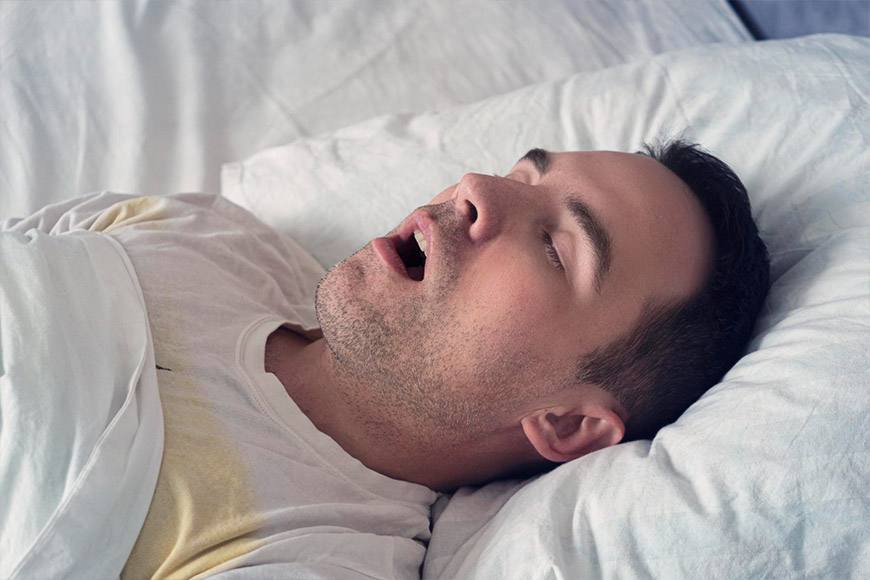
Snoring is a sound discomfort, but also a symptom of a serious illness
Snoring - audible discomfort, but also a symptom of a serious illness, Belgrade. TOP PRICE✓ Sleep apnea✓ CPAP therapy✓ Polysomnography✓ Risk factors and consequences.
Snoring is a sound discomfort, but also a symptom of a serious illness
Snoring is a sound phenomenon caused by the vibration of soft tissues in the oral cavity and throat during sleep. The treatment of snoring is complex and lengthy. We distinguish between occasional snoring, chronic snoring without pathological apnea, and snoring as a sign of obstructive apnea (OSAS). The cessation of breathing during sleep—sleep apnea—lasting a few seconds is a normal occurrence during the REM phase of sleep. Sleep apnea lasting 10 seconds or more in adults or 3 seconds in young children is a warning sign. An occurrence of 10 or more apneas during one hour of sleep is considered pathological, indicating the presence of sleep apnea disorder.
Sleep apnea is the cessation of breathing and/or a significant reduction in airflow through the airways during sleep, lasting longer than ten seconds.
The cessation of breathing or snoring during sleep is usually reported by the patient's partner, as the patient themselves is unaware of it. Due to this, the oxygen supply decreases, which can cause numerous issues.
Types of Sleep Apnea
- OBSTRUCTIVE SLEEP APNEA (OSA), which occurs due to partial or complete closure of the airways during sleep, with the presence of respiratory muscle contraction.
- CENTRAL SLEEP APNEA (CSA), occurs due to the absence of respiratory movements and therefore cessation of breathing, as the respiratory centers fail to send impulses to the respiratory muscles during the night.
- MIXED SLEEP APNEA represents a combination of these two types.
By severity, sleep apnea can be mild, moderate, or severe.
What are the Risk Factors for Sleep Apnea?
The most common risk factors for the development of sleep apnea include:
- Obesity,
- Associated heart diseases,
- Chronic obstructive pulmonary disease (COPD),
- Neuromuscular diseases,
- Hypothyroidism,
- Type 2 diabetes,
- Stroke,
- Pulmonary hypertension,
- Use of antidepressants,
- Alcohol,
- Sleeping pills,
- Smoking,
- Lack of concentration,
- Frequent mood swings,
- Falling asleep during work,
- Falling asleep while driving,
- Sexual dysfunction.
Symptoms of Sleep Apnea
- Snoring,
- Interrupted sleep,
- Restless sleep,
- Feeling of chest pressure,
- Daytime sleepiness,
- Excessive sweating,
- Waking up tired,
- Morning headaches,
- Decreased concentration,
- Forgetfulness,
- Frequent mood swings,
- Sexual dysfunction.
The consequences of this disorder are numerous: high blood pressure, coronary disease, heart attack, heart failure, strokes, and depression. All these patients have a poor quality of life.
How is Apnea Diagnosed?
A clinical examination is necessary but not sufficient to determine the type and severity of the disorder. Therefore, it is usually necessary to measure respiratory function during sleep using specialized equipment (polysomnography).
Polysomnography is the best tool for the most accurate diagnosis of sleep apnea and other respiratory disorders during sleep. Monitored factors include breathing, chest, and abdominal movements (using elastic belts with sensors), oxygen saturation, and pulse rate.
Treatment
Depending on the type and severity of the condition, the disease can be treated in several ways. The most common and mildest form of therapy involves using a device called CPAP, which patients wear via a special mask during sleep, helping them breathe in moments of apnea. This therapy is long-term but highly effective.
Do You Have Sleep Apnea?
Quick test for sleep apnea – visit the link and answer the questions to determine if there is a possibility you have sleep apnea.
How to Contact Us?
If you answered positively to three or more questions, it is necessary to consult a doctor and undergo polysomnography. To schedule your first examination and polysomnography, you can call 011/3752-752, 069/2282-900
For more information about the range of devices, aids and other products, visit our website eliksir.co.rs